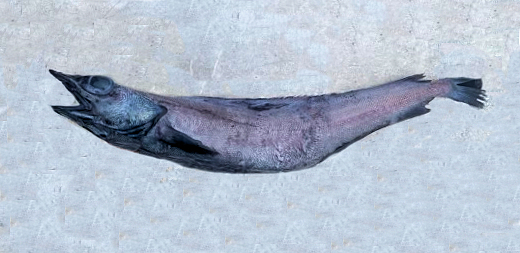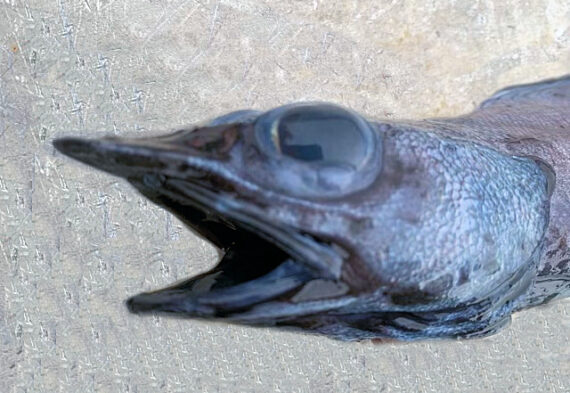Blue Antimora, Antimora rostrata

 Blue Antimora, Antimora rostrata. Fish caught from 1,600 foot coastal waters off Sitka, Alaska, July 2022. Length: 74 cm (2 feet 6 inches). Catch courtesy of Captain Keith Shouler, Sitka. Photograph courtesy of Captain Aaron Hooker, Sitka. Identification courtesy of Jason Wheaton, Cerritos, California.
Blue Antimora, Antimora rostrata. Fish caught from 1,600 foot coastal waters off Sitka, Alaska, July 2022. Length: 74 cm (2 feet 6 inches). Catch courtesy of Captain Keith Shouler, Sitka. Photograph courtesy of Captain Aaron Hooker, Sitka. Identification courtesy of Jason Wheaton, Cerritos, California.
The Blue Antimora, Antimora rostrata, is a member of the Moridae Family of Codlings that is also known as the Blue Hake, Flat-nose Codling, Long-finned Cod and Violet Cod, that is known in Mexico as Bertorella Azul, Brótola Azul, Locha Azul and Mollera Azul. Globally, there are two species in the Genus Antimora and both are found in Mexican waters of the Pacific Ocean.
The Blue Antimora are a uniform bluish-gray to black color. Their anal fin has a long base with 36 to 44 rays, their caudal peducle is long, their caudal fin is small and square, and their dorsal fin has a long base with 55 to 61 rays. Their head is depressed with a pointed snout, a chin barbel, disproportionately large eyes set on top, a large mouth that extends to the rear of the eyes with an overhanging top jaw, and a prominent bone that runs from the tip of the snout to under the eyes.
The Blue Antimora is an epibenthic and benthopelagic species that are found worldwide on the continental slope and upper rise at abyssal depths between 350 m (1,150 feet) and 3,277 m (10,750 feet). They reach a maximum of 75 cm (2 feet 6 inches) in length. They feed on benthic invertebrates. They form groups segregated by age, sex and size and move from coastal waters to deeper waters for spawning. Reproduction is oviparous with planktonic larvae. In the majority of locations females outnumber males, they are larger in stature and live longer. They have life spans of twnety-five years. The Blue Antimora is poorly studied with very limited information available about their lifestyle and behavioral patterns including specific details on age, growth, longevity, movement patterns, diet, habitat use, and reproduction.
The Blue Antimora is a resident of Mexican waters of both the Atlantic and the Pacific Oceans, however, they are exceeding rare in Mexican waters except along the west coast of the Baja.
The Blue Antimora is most likely confused with the Pacific Flatnose, Antimora microlepsis (uniform dark brown color, darker fin margins, lower gill cover dark).
From a conservation perspective the Blue Antimora is currently considered to be of Least Concern, with stable, widely distributed populations. They are caught as a by-catch of deep-water fisheries and although abundant they are normally not retained and discarded. Family members have been dated to the Miocene Period, 7.6 to 8.6 million years ago.